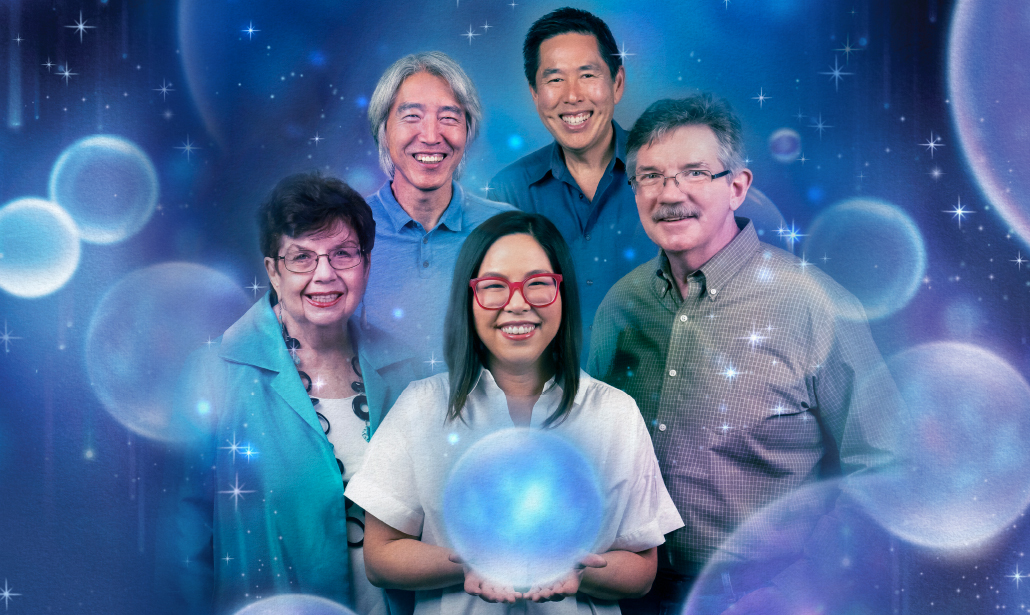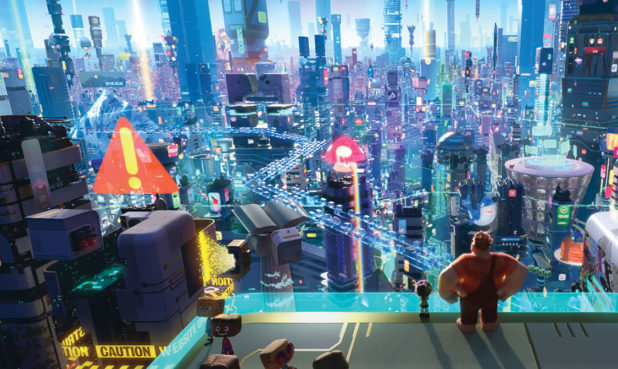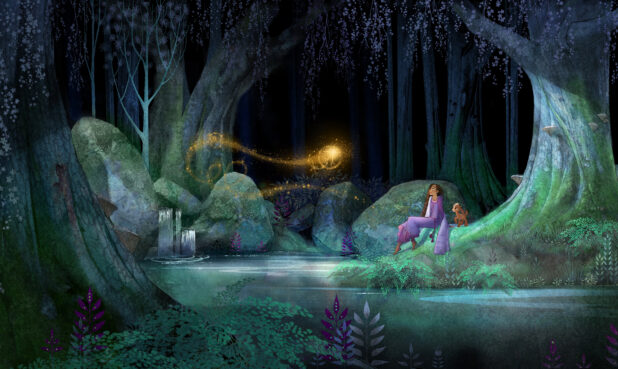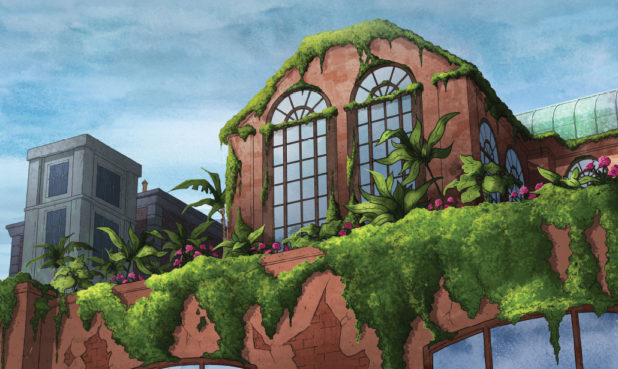
JANE BAER
Leading the Way
When Jane Baer (then Shattuck) visited L.A. on a vacation in the 1950s, she found herself touring ArtCenter and knew she wanted to attend. Despite being an artist himself, her father said no way. She could stay in Canada, get married, and have babies like other young women did. But Baer saved her money, hopped on a Greyhound bus, and started taking art classes.
“Luck followed me,” Baer says, “and when I ran out of money, Disney was hiring.” Her father’s old friend was Charlie Thorson, an early Disney artist, and because of that she was always intrigued by Disney films. She was thrilled to find herself in the same in-house animator training program that the men went through.
Because genders were separated then, she worked in a bullpen with six other women. But right down the hall were Marc Davis, Milt Kahl, Frank Thomas, and Ollie Johnston—members of Disney’s famed Nine Old Men. “We were all kids,” Baer says. “We didn’t realize how fortunate we were and what an experience it was. We [girls] could go in and talk to them. The doors were always open. They were so generous with their time and experience.”
Working as an in-betweener on Sleeping Beauty, Baer also did a bit of work under the direction of Thomas, who let her animate the candles in the iconic melting cake scene. But what she remembers most are Aurora’s eyes: “We had tough taskmasters on getting the eyes correct.” She used pencil and paper, working frame by frame, maybe a handful of drawings a day. “Drawing eyes day after day as they were expressing the story. Those eyes! I would go to sleep at night dreaming of eyes,” she says.
Baer married another Disney animator, Iwao Takamoto, and when Sleeping Beauty was done, she retired to suburbia. But she says: “I wasn’t cut out to be a suburban housewife making chocolate chip cookies. Coffee klatches—it was awful. I was totally miserable.” Several years later she was divorced and working in animation again.
During the following years, her career wove in and out of Disney. She returned as a full-time animator on The Rescuers, and she also worked on films including Pete’s Dragon, The Fox and the Hound, and Mickey’s Christmas Carol. A lot of the work was done outside the studio when they would offload overflow scenes.
Remarrying, she took on the last name Baer and co-founded The Baer Animation Company. She was the head of the studio when Disney asked if they would take over the Toontown and Benny the Cab sequences in Who Framed Roger Rabbit. Baer redesigned Benny and supervised his animation, working at the heart of a movie that would change the shape of what animation is capable of doing.
Baer calls the animation business a family, and she is now the last of “the girls” from the lifelong friendships she made in the bullpen. Reflecting on the origins of her career, she says: “Way back in the stone ages when I came into the business, women were not encouraged to progress like they are today. You were considered pushy if you tried to exceed your boundaries. If the male animators offered you something, that’s different. [But] nobody said, go out there and animate. We just did as we were told, really. It was a totally different time.”
Baer does not make these observations with bitterness. She also calls it a “wonderful time” and notes that it was hard for many of her male colleagues to advance, as well, because of the creative monopoly held by Disney’s Nine Old Men. So how did she manage to build the foundation for such a long and successful career? She credits a combination of stubbornness and “loving the business,” which she still does to this day.

Mark Henn
Changing of the Guard
In 1980, in his second year at CalArts, Mark Henn was hired at Disney. At that time, the studio was reaching the end of an era. His training program was under the direction of Eric Larson—the last of Disney’s Nine Old Men still working at the studio.
Henn started on The Fox and the Hound, assisting Glen Keane’s unit, and then was working on some effects when, a year in, in order to get a promotion, he was required to do a personal animation test. He based his on Mickey Mouse. This grabbed the attention of Disney veteran Burny Mattinson, who assigned the relative newcomer to animate the legendary mouse for Mickey’s Christmas Carol.
Henn calls being trusted with Mickey “certainly a good way to start.” It meant that he was being recognized for producing quality work. He did a brief stint on Black Cauldron before Mattinson pulled him over to The Great Mouse Detective. “Things took off after that,” he says.
“Working here at Disney has been a wish for me since I was small boy.”
This was a pivotal time for Disney as the studio figured out how to move beyond the Nine Old Men who had helped shape it. “Obviously there was the literal changing of the guard,” Henn says. “But there was also a lot of dust yet to settle when I started because [they’d just had the] Don Bluth exodus.” Bluth had left to start his own studio, taking more than a dozen Disney animators with him. “That left Fox and the Hound in the lurch,” says Henn. But while the moment was a rocky one, he feels it opened up opportunities that he and other animators might not have had right away “had Bluth stuck around.”
A few years later, Jeffrey Katzenberg took over Walt Disney Studios, and changes were afoot again. There had been ongoing doubts about whether The Fox and the Hound should be finished. Finally, Katzenberg said, “’We’ll make it, but I want it made in 18 months,’ which was at that time unheard of,” says Henn. “[Disney] just made movies, and every two or three or four years at some point somebody would say, oh, I think we can wrap this thing up in six months and let’s make that our target. It’s not like it is today where you set release dates and almost back into it. That was a big adjustment that of course affected everything since then.”
As the 1990s arrived, Henn participated firsthand in the Disney renaissance that snowballed with the Academy Award for Best Picture nomination for Beauty and the Beast. He was the Supervising Animator for Belle, as well as The Little Mermaid’s Ariel and numerous other iconic characters. But Henn believes there was a natural progression that led to the era of blockbuster successes. “With The Great Mouse Detective, things started to turn around. I think there was a trust the studio was developing with our [new] generation of artists,” he says. “The stories, the ideas, the management that we had. We grew in confidence as to our abilities. We had an enthusiasm, we had some success. That was the stepping stone to each subsequent film—a little bit better and a little bit better after that. … Working here at Disney has been a wish for me since I was small boy. Having that opportunity to be the next generation after the first generation—I’ve been very blessed.”

Jin Kim
Opening New Doors
Any company in business for a century inevitably undergoes major transitions, and when Jin Kim arrived at Disney in 1995, the studio was experiencing one of those moments. DreamWorks had just launched its animation studio, siphoning off Disney animators in the process. But loss can lead to gain, and “Disney Studios started hiring new people from all around the world,” says Kim. “That opened the door wide open.” Born and raised in South Korea, he was working in Toronto and wasn’t sure if Disney would hire him, but he thought it was worth a try.
Kim started as a 2D animator before another seismic shift took place in the animation industry. The success of Toy Story ushered in an era of CG, so Kim pivoted, learned CG animation, and became a CG animator. “That was brutal,” he says. “A lot of old-time animators, veterans, they tried to learn new technology … they couldn’t adapt, and they left.”
Kim, on the other hand, continued to evolve. After spending his first decade at Disney as a Visual Development Artist, he began working on Bolt. Character Designer Joe Moshier asked him to do some additional character designs. Slowly, Kim learned more about the designing process, and while he was working on Tangled, Director Glen Keane offered him a choice between CG animation and character design. Kim chose the latter, designed some of the movie’s characters, and embarked on a completely new path.
“There are not many people [who could] work here 20 years, 30 years … and I’m one of them. I feel lucky.”
Kim went on to create some of Disney’s most popular modern characters for movies like Big Hero 6, Wreck-It Ralph, Zootopia, Raya and the Last Dragon, and Encanto, and he played a significant role in the look of Elsa in Frozen. But if he had to choose, he considers Tangled the most meaningful project he’s worked on. He spent almost four years on it “under the supervision of a great artist. He taught me so much,” Kim says. “It was almost intimidating working with Glen, to show him my drawings to get approved. But at the same time, I was so excited … I could learn.”
As the years passed, Kim observed another change in the studio: a more inclusive environment with the hiring of more women and people of color. And the characters began to reflect the broader world. “Moana is an example. Big Hero 6 is another good example,” he says of the movie he worked on as a Supervising Animator in which the main character is half Japanese.
If Kim were to offer any advice to his younger self starting out, he says he would have explored more, traveled to different countries, and “watched other people’s lives, how they live,” he says. “Eventually, I think, those experiences can become your asset to work on movies.” Ever adaptable, he’s instead broadened his horizons on the job, and his career has been filled with high points both professionally and personally, like when he was in South Korea for the premiere of Big Hero 6, and the audience cheered their own “hometown hero.” As for Disney, he calls it a dream come true. “I just wished I could stay here five years, and it became, after five, oh another five would be nice. Ten years became 20 years,” he says. “There are not many people [who could] work here 20 years, 30 years … and I’m one of them. I feel lucky.”
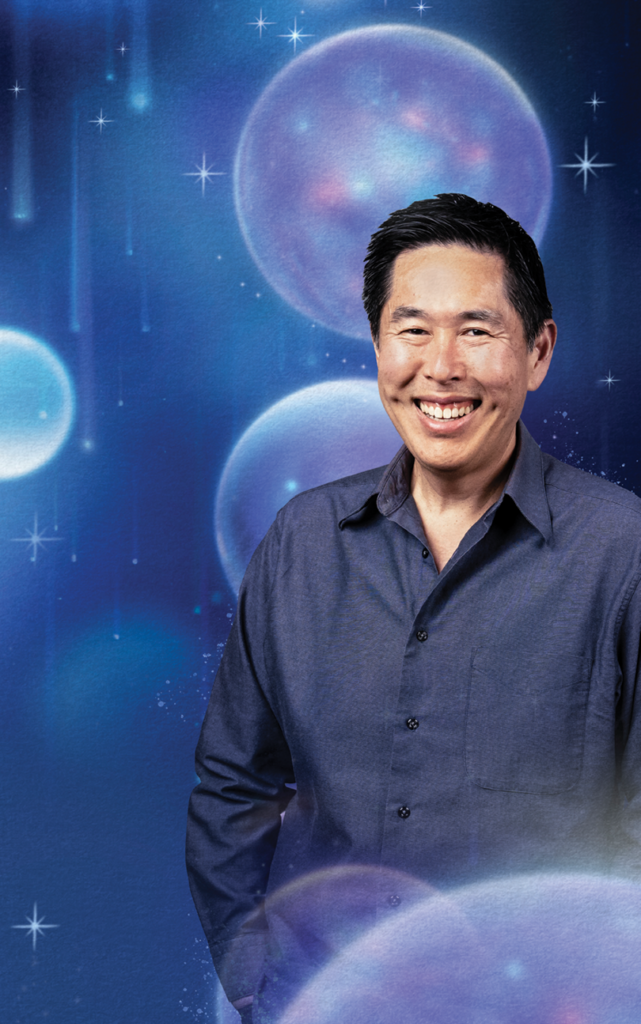
Dale Mayeda
Strengthening Ties
It’s no exaggeration to say that The Lion King changed Dale Mayeda’s life. A Computer Science grad from UC Irvine, he entered the job market when the economy was taking a nose-dive, and he wound up working as an assistant manager at Enterprise Rent-a-Car when he went with a group of friends to see the story of Simba. “They had that sequence where the wildebeests come over the cliff—it was so visceral and amazing,” he says. “I was like, I don’t know how I’m going to do it, but I’ve got to get into that. I figured they must have used computers because there was so much dimensionality to the movement of the camera.”
Not long after, he walked into his job and quit. His sister was interning at this time with a company developing software that would eventually become Maya. Call it a perfect storm. He took a class, sent what he calls his “terrible reel” all over Hollywood, got work at some small post-production facilities, and eventually landed at Disney at the turn of the millennium, working in the live-action division. After a few months he was brought over to supervise the effects department on what was to be the studio’s first CG film.
That film didn’t pan out, but not long after, he was hired as Effects Supervisor on 2005’s Chicken Little. While this is the movie that would become Disney’s CG first, Mayeda says the filmmakers wanted it to have characteristics of a 2D film in areas like style and animation. But around that time many 2D animators were leaving and there was “a lot of weirdness,” he says. So they put together a crew that combined both 2D and 3D Effects Animators. “We tried to create an environment where we’re all effects animation and it doesn’t matter whether you’re 2D or 3D. We tried to make it as collaborative as possible. It actually worked. It started fostering an environment within our effects animation department where there wasn’t any sort of rivalry—people were really helping each other.”
Being able to experience both sides of the craft has been meaningful for Mayeda. As a kid he loved to draw, and teachers praised him for being good at art. But when he started high school, “Macs were starting to happen. PCs were starting to happen,” he says. “It was exciting and new. Then when I was in college, that first year, I took an art class with some of my other computer science friends … and we were like, we should switch.” In the end, he felt the need to be practical. While he wishes he’d studied both art and computers, he says he’s lucky because being on the job “feels like [I’m always] taking this master class in design, style, and shape language.”
The industry leap from 2D to CG had already happened when Mayeda came on board, but there were still big changes to come. He notes the arrival of Pixar as “probably the biggest shift,” explaining that before, you worked within your department and didn’t get to see much of what everyone else in other departments on a film were working on. But when Disney bought Pixar, that studio’s influence permeated the workflow at Disney, opening doors for all of the departments to collaborate together.
Mayeda says the first time they tried it was on Bolt. At first it didn’t feel comfortable with so many people commenting on his work, but by the end of the show he thought: “Wow, this is amazing. Since then, we’ve become an extremely collaborative [studio] to where everyone’s showing everyone stuff and throwing in ideas and working really tightly together … collaborating not just in our department but across multiple departments, to always take whatever we’re creating to the highest level.”

Fawn Veerasunthorn
Celebrating Fresh Voices
Persistence pays off. Fawn Veerasunthorn is proof. Having always wanted to work at Disney, she applied three times. “It became my hobby,” she says. “When I see them put out a posting, I think, oh, it’s that time of year.”
Veerasunthorn originally applied with production work she had done at other studios. She got feedback that the work was great, but it didn’t reflect who she was as an artist. “That’s when I started doing comics on the side,” she says. “I found that I’m doing storyboards during the day, and at night I get to know who I am, be myself. I put those in my portfolio.”
Veerasunthorn always loved drawing and hoped it was something she could do for a living. Growing up in Thailand she was told that wasn’t possible. Fortunately, her family was supportive of her going to school for art, but even then she was told, go try it for a year—you’ll be back. Instead, her third interview using artwork demonstrating her personal talent landed her a job at Disney and a first credit as a Storyboard Artist on 2013’s Frozen. “I’ve been here ever since,” she says.
She went on to work on Zootopia, Moana, and Frozen 2. Then came Raya and the Last Dragon, where she was Head of Story. “That was a big step, a learning curve,” she says. “Not only working on my own sequences, [but] the big picture of the film. That’s when I started understanding, the film has to mean something to the person making it.”
Veerasunthorn still considers her job a never-ending education. “I have favorite artists that I stalk at work,” she says, naming colleagues like Chris Williams, Byron Howard, and John Ripa who became her mentor on Raya. “His work has been so iconic, and I’m like, how do you pick those moments and have people remember [them] forever,” she says. “Because that’s what happens with Disney movies, right? They live on beyond their own life.”
This is something Veerasunthorn learned more about during the part of the Disney movie-making process where a film is screened for the entire studio. “What I found was they would pick out … just one image per sequence so people could talk about it and refer back,” she says. “Early on I’m like, they never use a really great image of mine. [And] I thought, it’s not them, it’s me. I need to work harder on finding the moment to represent that sequence.” From that point on, she focused on identifying those images, and as she evolved into a position of leadership, “I told everybody, think about that, find that first, and then make that your true guiding light,” she says.
Veerasunthorn embodies the demographic change that has taken place at Disney. Young, female, and Thai, she was a director on the movie Wish. Age is relative, though, as she talks about the even younger generation and how what influenced her as a child is so different from what influenced them. Japanese manga, for example. “Also the breadth and variety of what everyone has been exposed to,” she says. “I think that helps with bringing in the modern sense of storytelling.”
Still, she notes, with younger animators she sees a lot of anxiety. “Am I good enough? I’m working at Disney, and everyone is so much better,” she says. She wants to tell them that everyone deals with that, and she gives them the advice she wishes she could have given her younger self: “Trust my instincts a lot more. Go with my gut. In the beginning of a career there’s so much pressure of trying to fit in … Something I learned over time [is] to not shy away. When I have something bubbling up in me, just speak up, speak it out, it will be okay. We’re all friends, we all respect each other. I wish that people would recognize how powerful the spark of hope within you is. That’s what kept me going all these years.”
